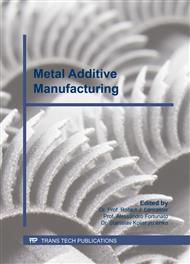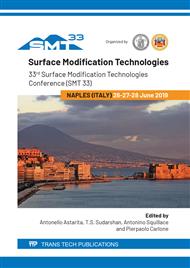[1]
S.A.M. Tofail, E.P. Koumoulos, A. Bandyopadhyay, S. Bose, L. O'Donoghue, C. Charitidis, Additive manufacturing: scientific and technological challenges, market uptake and opportunities, Mater. Today 21 (2018) 22-37.
DOI: 10.1016/j.mattod.2017.07.001
Google Scholar
[2]
S. Ford, M. Despeisse, Additive manufacturing and sustainability: an exploratory study of the advantages and challenges, J. Clean Prod. 137 (2016) 1573-1587.
DOI: 10.1016/j.jclepro.2016.04.150
Google Scholar
[3]
D. Herzog, V. Seyda, E. Wycisk, C. Emmelmann, Additive manufacturing of metals, Acta Mater. 117 (2016) 371-392.
DOI: 10.1016/j.actamat.2016.07.019
Google Scholar
[4]
S.M. Thompson, L. Bian, N. Shamsaei, A. Yadollahi, An overview of Direct Laser Deposition for additive manufacturing; Part I: Transport phenomena, modeling and diagnostics, Addit. Manuf. 8 (2015) 36-62.
DOI: 10.1016/j.addma.2015.07.001
Google Scholar
[5]
N. Shamsaei, A. Yadollahi, L. Bian, S.M. Thompson, An overview of Direct Laser Deposition for additive manufacturing; Part II: Mechanical behavior, process parameter optimization and control, Addit. Manuf. 8 (2015) 12-35.
DOI: 10.1016/j.addma.2015.07.002
Google Scholar
[6]
M.A. Obeidi, E. McCarthy, B. O'Connell, I.U. Ahad, D. Brabazon, Laser polishing of additive manufactured 316L stainless steel synthesized by selective laser melting, Materials 12 (2019) 991.
DOI: 10.3390/ma12060991
Google Scholar
[7]
M. Troiano, P. Salatino, R. Solimene, F. Montagnaro, Wall effects in entrained particle-laden flows: The role of particle stickiness on solid segregation and build-up of wall deposits, Powder Technol. 266 (2014) 282-291.
DOI: 10.1016/j.powtec.2014.06.039
Google Scholar
[8]
F. Blateyron, The areal field parameters. In: Leach R, editor. Characterisation of Areal Surface Texture. Berlin Heidelberg: Springer-Verlag, 2013 p.15–43.
DOI: 10.1007/978-3-642-36458-7_2
Google Scholar
[9]
F. Scherillo, Chemical surface finishing of AlSi10Mg components made by additive manufacturing. Manuf Lett 19 (2019) 5–9.
DOI: 10.1016/j.mfglet.2018.12.002
Google Scholar
[10]
E. Atzeni, M. Barletta, F. Calignano, L. Iuliano, G. Rubino, V. Tagliaferri, Abrasive Fluidized Bed (AFB) finishing of AlSi10Mg substrates manufactured by Direct Metal Laser Sintering (DMLS), Addit. Manuf. 8 (2016) 15-23.
DOI: 10.1016/j.addma.2016.01.005
Google Scholar



